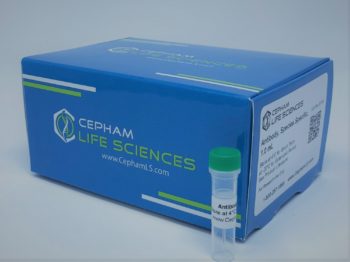Description
Aliases
HD4/HD5/HD9
Antibody Type
Polyclonal Antibody
Uniprot ID
Swiss-Prot: P56524 Q9UQL6 Q9UKV0
NCBI Protein:
Immunogen
Peptide sequence around phosphorylation site of serine 246/259/220 (T-A-S(p)-EP) derived from Human HDAC4/HDAC5/HDAC9.
Raised In
Rabbit
Species Reactivity
Human
Tested Applications
WB IHC Recommended dilution: Predicted MW: 140 124 111 kd, Western blotting: 1:500~1:1000, Immunohistochemistry: 1:50~1:100
Background / Function
Histone Deacetylases (HDACs) are a group of enzymes closely related to sirtuins. They catalyze the removal of acetyl groups from lysine residues in histones and non-histone proteins, resulting in transcriptional repression. In general,they do not act autonomously but as components of large multiprotein complexes, such as pRb-E2F and mSin3A, that mediate important transcription regulatory pathways. There are three classes of HDACs; classes 1, 2 and 4, which are closely related Zn2+-dependent enzymes. HDACs are ubiquitously expressed and they can exist in the nucleus or cytosol. Their subcellular localization is effected by protein-protein interactions (for example HDAC-14.3.3 complexes are retained in the cytosol) and by the class to which they belong (class 1 HDACs are predominantly nuclear whilst class 2 HDACs shuttle between the nucleus and cytosol). HDACs have a role in cell growth arrest, differentiation and death and this has led to substantial interest in HDAC inhibitors as possible antineoplastic agents. Cress, W.D. and Seto, E. (2000) J Cell Physiol 184, 1-16. Vigushin, D.M. and Coombes, R.C. (2004) Curr. Cancer Drug Targets 4, 205-218. Marmorstein, R. (2001) Cell Mol Life Sci 58, 693-703. Thiagalingam, S. et al. (2003) Ann. N.Y. Acad. Sci. 983, 84-100.
Conjugate
Unconjugated
Storage Buffer
Supplied at 1.0mg/mL in phosphate buffered saline (without Mg2+ and Ca2+), pH 7.4, 150mM NaCl, 0.02% sodium azide and 50% glycerol.
Form
liquid
Storage
Shipped at 4°C. Upon delivery aliquot and store at -20°C or -80°C. Avoid repeated freeze.
Purity
Antibodies were produced by immunizing rabbits with synthetic phosphopeptide and KLH conjugates. Antibodies were purified by affinity-chromatography using epitope-specific phosphopeptide. Non-phospho specific antibodies were removed by chromatogramphy using non-phosphopeptide.
Modification
Phospho-Ser246/259/220
Additional information
| Size | 100?l |
|---|


